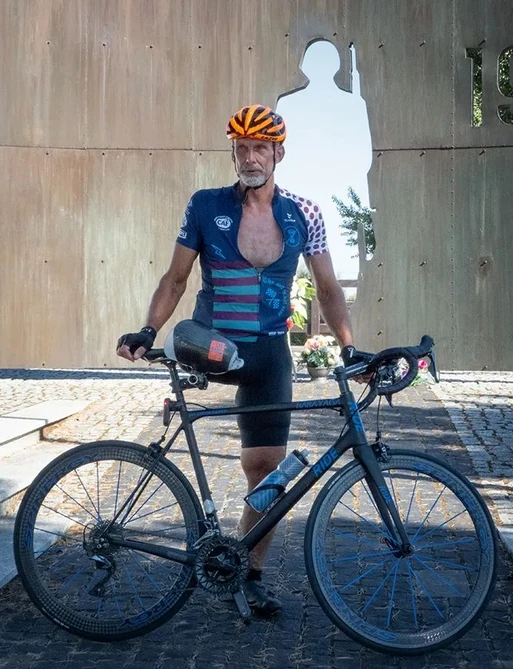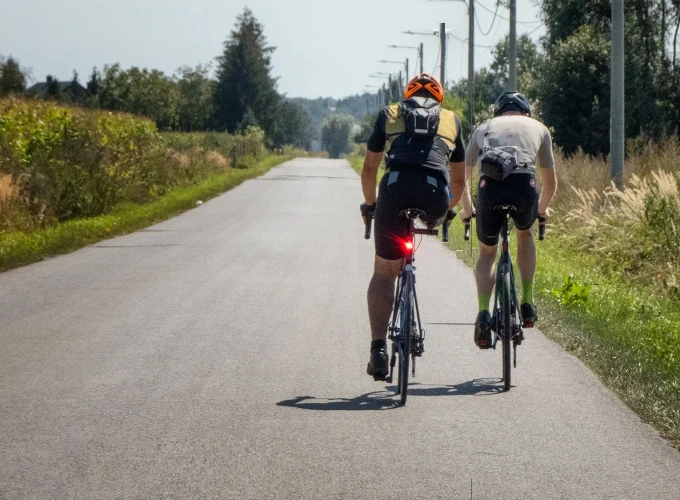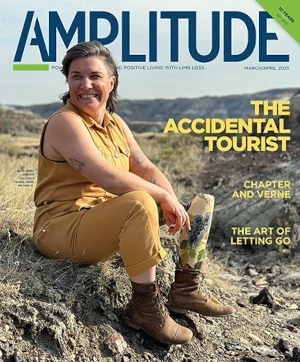
“Recovery from limb loss is 10 percent physical, 90 percent mental,” Jakob Kepka says. “If you decide you’re going to do something, you do it. Other people might think your goals are illogical or irrational, but they’re your goals. So don’t listen to them.”
Kepka didn’t listen when people questioned the sanity of his HopeRaising Expedition, a bicycle ride from Krakow to Kyiv to lift spirits, inspire hope, and raise funds on behalf of Ukrainian amputees. After more than a year of planning, he left Krakow on August 10 and is now about halfway through the 900-kilometer (560-mile) journey, supported by the Freedom Space Foundation. By the time you read this, Kepka will have reached the Ukrainian city of Kremenets. He’ll cover the remaining 410 kilometers, pedaling on one leg, over the next two weeks, and reach Kyiv on September 11. Assuming all goes well.
That can’t be assumed, of course, given the missile barrage that Russia unleashed on targets across Ukraine this week. Just two days ago Kepka had to delay the start of his ride from Złoczów to Tarnopol because of an air-raid alert. “Alarms are a daily occurrence in Ukraine,” a HopeRaising volunteer noted on Facebook. “The further east we go, the more frequently they appear.”
But the 67-year-old Kekpa is not the type to scare easily. A Canadian citizen, former US Marine, and above-knee amputee, he’s bicycling across war-torn Ukraine because of the danger, not in spite of it. Ever since Russia invaded in the late winter of 2022, Kepka has risked time, money, and personal safety on behalf of the besieged nation. During 2022 he spent six months building barracks and renovating health clinics in western Ukraine. Last year he helped amass a few crates’ worth of prosthetic components for Penta Prosthetics, which donated them to Ukrainian limb-care facilities.
Those experiences provided the impetus for the HopeRaising Expedition.
“In the rural areas of Ukraine, I kept hearing the same story,” Kepka says. “You know: Andre’s 32 years old, he’s got a wife and two kids, he lost an arm or a leg at the front, and now he thinks his life is over. He lives in this small town with rudimentary medical care, and no one’s gonna give him a job. That bothered me, because I don’t believe anything like that myself. You do what you want to do, regardless of your physical disability. You just figure out. I thought there’s got to be a way to get such an idea across, to inspire people.”
You can chart the HopeRaising Expedition’s daily progress on Facebook and Instagram, and you can make a donation at the project’s Zrzutka page. Most of the social media content is posted in three languages (Polish, Ukrainian, and English), but you might need to hit the “translate” button for some of it.
Kepka is a pretty fascinating guy. We spoke with him last summer, when he was in the early stages of organizing the trip. A portion of our conversation is presented below, edited for length and readability.

What got you so interested in helping Ukrainian amputees?
I was born in Canada, but my dad was a Polish veteran. He was a Polish patriot, and I was raised Polish, not necessarily North American. The thing he drilled into me is that Poland’s your real home, and there’ll be a time in your life when you’ll have to go. It’ll be threatened again, and it’s your duty to go.
When the war in Ukraine started, I was watching CNN, the BBC, all the news feeds, and I was getting upset. More than upset—I was getting pretty angry. And I’m an angry person as it is. I couldn’t just sit around, so I started Googling humanitarian aid agencies that were recruiting volunteers to help the Ukrainians. I found this American group called Volunteers for Ukraine that recruited vets—former police, firefighters, and soldiers. [Kepka is a former US Marine.] I filled out the application, but I didn’t think I’d get a response, because who’s going to want a 60-something, one-legged guy?
But one of the questions was, “Do you speak any of the following languages?” And Polish was one of them. So I clicked yes, they got in touch with me, and they said they were working with a Polish foundation called Folkowisco. They were talking about creating a handyman team, and I have a background in construction, so they asked, “Would you be interested in being a member of that? We need your language skills.” I said sure, and they asked, “When can you go?” So I went over there in about June of 2022 [three months after the Russians invaded].
Were you focused on helping amputees right from the start?
No, we were just building facilities. We built a squad bay on the second floor of Folkowisco’s warehouse [in southeastern Poland] for volunteers to live in. I later moved into it myself. Then we went on to our next project, in a village called Nahachiv, just over the border, about 10 or 12 kilometers into Ukraine. The director of the hospital there asked us what we could do to fix up the building, and we said, “Tear it down. It has black mold, big holes in the roof.” So then he took us to the plaza and had us look at the second floor of a block in the old Communist-era office spaces. He asked us, “Can you renovate four of these offices and make them into a workable clinic?” We started on that project on July 4, your Independence Day, and we finished at the end of October.
I was there almost six months in total, between Poland and Ukraine. While I was over there, I traveled around a fair amount on weekends, and I was meeting a lot of new amputees. They would ask me about my prosthetic: “What kind of leg is that? Is it expensive?” And I would tell them, “Yeah, it’s very expensive. But it’s not a question of the quality of the leg so much as where your head’s at.”
Three weeks after I got home, I went to Montreal to have osseointegration surgery, and I was trying to figure out a way to continue to help in Ukraine. So my idea was: I’m a cyclist, and I can use that to inspire people and raise funds to get prosthetics to amputees in Ukraine.
Tell me about your cycling background.
That was my sport before I got hurt. It’s a sport I was interested in as a kid. The typical farm boy in Eastern Ontario in the 1970s would not even think about cycling, because it was weird. It’s not hockey, it’s not football, it’s not traditional. But I’ve never been what you would call a traditional person.
I got pretty serious about bicycling after I screwed up my leg in the Marine Corps in the 1980s. I already had a weak knee, and I screwed it up worse in the Marines and got discharged. I couldn’t run anymore, and you can’t be an infantryman in the Marines if you can’t run.
And how does a Polish-Canadian guy end up as a US Marine?
That’s another story. And it might get my old recruiter in trouble.
OK, then. Let’s move on. You got discharged, and then what?
I rode competitively until about 1999, and then I couldn’t ride anymore because my knee was that bad. In 2001 I had the first of six knee replacements and revisions in a 13-and-a-half-year period. After surgery number six, I got my wish. I got my leg cut off.
When did you start advocating for that?
After the fourth one failed. My surgeon wanted to fuse the knee, and I said no, because I knew people with fused knees. After the amputation, one of my goals—you know, in the rehab center, they ask “What are your goals?”—and one of mine was to get back on the bike. I had no idea how amputees rode, and I didn’t have a bike anymore, but I was determined to do that. This was right after the London Olympics and Paralympics, and a European cycling magazine called Roller had an article about a Spanish cycling team that was made up of amputees. I was going to see my son in France that year, so I went to Barcelona and met their coach and their top rider, a gold medalist who’s a double amputee. He’s an AK and a disarticulated shoulder amputee, all on the left side.
They told me to go back to Canada and get a racing license for insurance purposes, so if I crashed someplace I’d be covered. So I did that, but I didn’t have enough money to get a bicycle. Then another amputee told me about the Challenged Athletes Foundation, and I applied as a vet to Operation Rebound, and that’s how I got my first bicycle. They’ve been supporting me ever since then.
In 2018 I went back to Barcelona, and that’s where I learned how to pedal correctly. None of the cyclists on that team in Barcelona wore prosthetics. They all pedaled with one leg. So I went and trained with them for two weeks, and it was discouraging. We would ride up in the hills of Barcelona, and I would just fall over from exhaustion, like that guy in Laugh-in on the tricycle. Literally, that’s what happened. I couldn’t get my foot out of the clips, and I would just fall over. And they’re showing me no mercy whatsoever. They’d be upset because we only did 140 kilometers that day.
I came back home and eventually got back into shape, and by 2021 I clocked between 13 and 14,000 kilometers on the local roads.
From a practical perspective, what was involved in organizing the HopeRaising Expedition?
I had to find a humanitarian aid agency dealing with prosthetics that had projects in Ukraine, so that people who donate can get the tax receipt. I started with the Ukrainian Canadian Congress. You may not know this, but the largest diaspora of Ukrainians in the world is here in Canada, We have about 2 million people that identify as Ukrainian. There’s a big concentration out west in Manitoba, Saskatchewan, and Alberta. They were the ones who came in the early part of the 20th century and were given, basically, 50 acres and a mule. Those are the people who settled that area. You see old Ukrainian churches scattered all over the place in the middle of the wheat fields out there.
The UCC doesn’t support projects like this, so then I called my Polish contacts and they put my in touch with the Freedom Space Foundation. They said they’d support me, and they talked to their Ukrainian friends and set up a route and identified riders to join me as I go through towns. There are safe biking roads in Poland, but not so much when you cross the border. Ukrainians drive like maniacs.
I could do the ride in two weeks, but there’s also the thing of Eastern European hospitality. I’m not just gonna pedal through towns without stopping. There’s a lot of social and promotional stuff. I gotta kiss babies and shake hands and be asked by old grandmothers if I am married and do I want to meet their niece or granddaughter. I have to be told by a lot of Ukrainians, “You know, for a Pole, you’re not a bad guy.”
The HopeRaising Expedition continues through September 11. You can make a donation at the project’s Zrzutka page.




